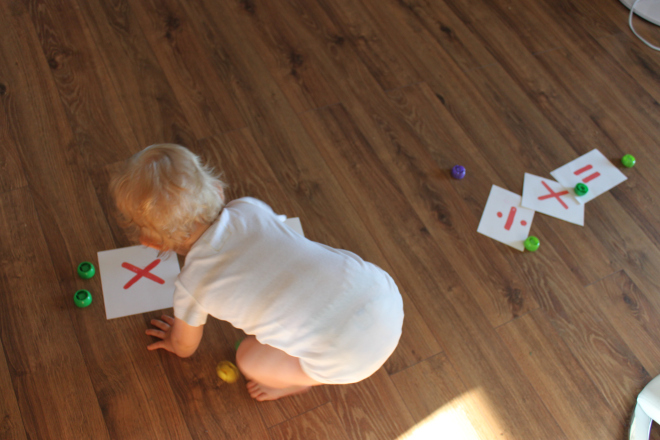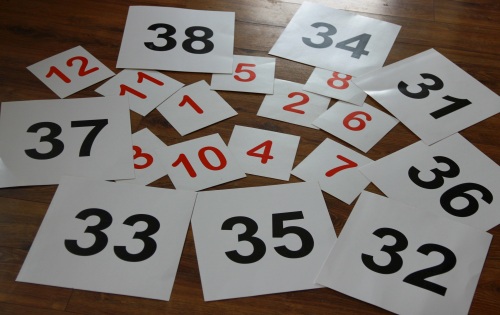
The maths set with dot cards contains a small manual. It says there that after we complete the part of the maths programme based on dot cards, we can wait with introducing numerals until nursery school. We can, of course, but we don’t have to. We have already started numerals as Doman doesn’t say anything like that in his book: “How to Teach Your Baby Math.”
Moreover, he repeats over and over again that the earlier we start the better and I have always had this on my mind. My experience concerning the early reading programme confirms this. When we start with a few-month-old baby it is much easier for a parent: a baby’s full attention is directed towards the cards. There is not need to modify the method or to get creative with our presentations.
The older a child is, the more creative, flexible and observant we must be. As you know when Maja was around 10 months old we were quite well with plain cards with English words only without any pictures. Now I find it hard to imagine presentations with such cards in the Polish language. Maja is 17 months old and she needs more attractive presentations and they are. The programme and the cards must be more appealing than ever and they are because we have a completely different set of cards for the whole-word reading programme in Polish.
Speaking of maths, Glenn Doman claims that time for dot cards is over when the child is 30 months old. It seems logical that we have to start really early, especially that most parents are able to deal with only one set of cards daily like my husband. I already mentioned here that there is no need to stick stubbornly to the quantitative scheme. The way we follow Doman’s programmes depends on a parent and a child. Doman puts an emphasis on this, however from some comments all over the Net I infer some parents just study his basic programme and do not continue further with his book and they overlook this important tip saying that we should modify this basic programme according to our child’s needs. Many think that they are obliged to follow his intricate maths programme and stick to it in 100%. After reading his book in English I have to say it is quite obvious he strongly implies introducing changes depending on the child’s age and attitude. The basic programme in its first form is for infants and small babies.
NUMERALS 1-20
The manner in which we present the cards with numerals is exactly the same as it is in the case of dots cards. Doman suggests beginning with 2 sets: 1-5 and 6-10. After five consecutive days we pick one card in each set and take it away. We put a new card in place of each retired one. We repeat this process daily. We flash the cards in each set 3 times daily. It is important to present the new card as the last one when we introduce it for the first time. In the following sessions we always mix the cards so that they are in a different order each time. We can also mix cards from different sets together, thus creating new sets. You have probably noticed the method is the same as in case of Doman’s reading programme.
I started introducing dot cards from 2 sets of cards. After some time I added the third one. Each set was presented 3 times daily. Then, I introduced equations, Doman’s reading programme, picture flashcards and I started doing an extremely large number of sessions daily. I mentioned this when writing about how it all began both with maths and with the whole-word reading.
I have returned to work for good and without any stress I manage only one set of 5 cards with numerals. We still read books on daily basis and I flash picture cards every day and there is much more going on. Thinking about the past I believe I could have had three sets of numeral cards daily at the beginning because I started during summer holidays. However, despite I had some free time, I decided to stick to one set only because I had our few-day trip to Mazury (a region in Poland famous for its lakes) on mind as well as my return to work in September.
I remember that at the end of our reading programme with ready-made set of cards in English, I desperately needed to have less and less sets because Maja was learning to walk. However, I couldn’t just limit the number of cards from one day to another. It took some time. You can read here how difficult it was to diminish the number of sets.
Because of this I do not go crazy with number of sessions per day or with number of cards shown daily. We have slowed down significantly but we are still making progress. There is no pressure. I am really relaxed because we have plenty of time unlike at school. I am fully aware of the fact that we have completed the most important step for which there is a time limit up to the age of 30 months. This is Doman’s programme with dot cards.
On my return to work, I was a bit worried if I manage to do 9 flashcard presentations daily which I sort-of imposed on myself combined with other fun activities with our baby. I decided then that our priority is maths and that if I didn’t manage I would quit picture flashcards which I regarded less important. As for picture flashcards, I have so many of them that although I probably started showing them to Maja in June (at least I think so because I mentioned them here), I still continue to present them to my daughter. I introduce one new card daily and we have only completed a half of them.
Luckily, despite my apprehensions, it seems I am organized enough. I am able to do everything I had planned and there is no need to abandon anything.
COMPARISONS
After I presented numerals 1-20, I continue with those 21 upwards in the same way but I started showing them with reference to the number of dots. This means mixed comparisons.I choose one numeral card out of all these which have appeared 15 times (3 times daily for 5 days) and three dot cards as well as comparison signs. during one session I compare a chosen numeral to a number of dots in three different ways. I show that a numeral on one card is greater than, less than or that it equals a number of dots on the other card. You can see an exemplary “lesson” in the pictures below. I don’t show comparisons all at the same time but one after another.
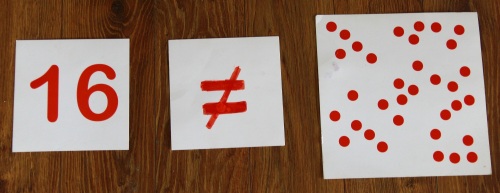


Actually, we have already had similar comparisons with dots. You will find the details here.
HIGHS AND LOWS WHEN IT COMES TO MAJA’S INTEREST IN THE CARDS
Every child is different and maybe it will be different in your case but my daughter lost interest in the cards after I presented numerals 1-20. According to Doman a child is bored and loses its interest when we present the cards too slowly or when we introduce new material too rarely. Following his suggestions I started retiring 2 cards and adding 2 new ones daily to speed up introducing new material. I worked magic. I am sure now my baby loves maths.
I already mentioned in May and June blog entries that I was under the impression that Maja prefers maths to reading. I am not the only person who noticed that. For a few recent days she she has been asking for more and more comparisons. She just catches a glimpse of numbers or jumps on numer cards or even takes them and runs away with them. Unlike with comparisons, after I present all five cards with numbers it is the end. I already mentioned our games with cards here but I think I have to write a follow-up because it gets much more interesting with a child who can run.
I left comparisons for the end of the day after we have done everything else. When I work I am able to present only one session with three comparisons daily. However, it happens that I manage to show two or more sessions like I have been doing for the last few days. I guess I have become more organized and now I can manage my time better.
A few days ago, after supper, Maja was sitting in her high chair and looked a bit sleepy. I decided to give it a try and to show her just one comparison. I was ready to stop immediately if she showed no interest in the cards. I placed a number card, a dot card and an equals sign between them in front of her. I said the whole comparison pointing to the cards as I was saying it. As soon as I took the cards away I heard her saying “more.” I was a bit surprised because she looked sleepy before, I showed her another comparison. She asked for more again. Amazing! And again … and again …As you can see it is easy to fall in love with maths if you are not aware of the fact that you actually learn it.
I finally decided we had to finish. Doman advises to stop before your child wants to stop and not provide him or her with more even if he or she asks for it. A child should be left craving for more and not fully satisfied.
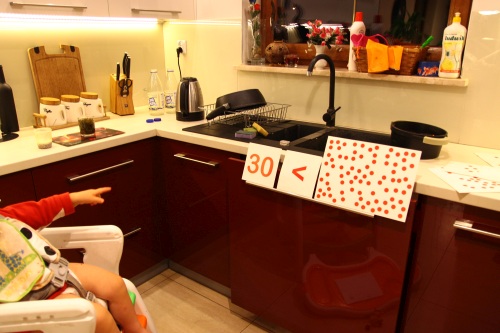
NEW SET OF NUMERAL CARDS
It just happened that our set of maths cards included only digits 1-30. Immediately after we completed it. It was obvious that I needed to buy more number cards. I ordered numbers 1-100 from WczesnaEdukacja (a Polish publishing company). The new numerals are huge when compared with these I have had so far but I like that. You can see the difference in the main picture for this blog entry. They attract Maja’s attention although they are black, not red like these in the set we have been using up to now. We have a real mixture of cards now as you can see both in the main picture for this blog entry and in the comparisons which I present below. I think I will stick to these huge cards even with numbers 1-30 in case of which I had smaller cards. At the moment we are learning number 43 and I still find it hard to believe I am doing this with a 17-month-old baby 🙂
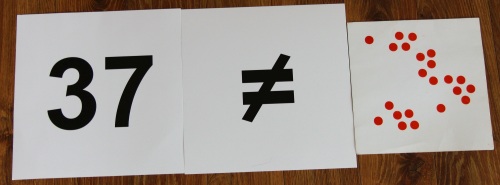
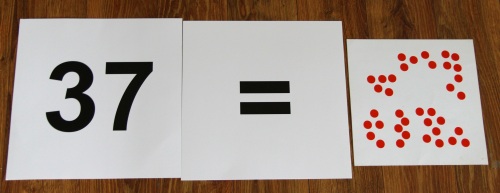
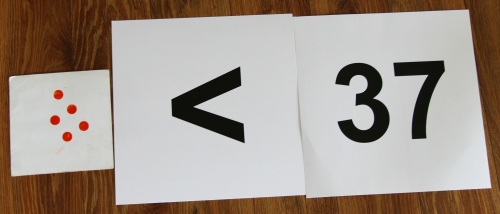
Have you found my experience useful? If yes, share with others. What about you? Have your little ones had their first contact with maths yet or are you waiting for school to provide that? I would be really delighted if you leave a comment and share your experience.
You are invited to follow Facebook fanpage and to subscribe for this blog to get notifications about every new post.
I have created a Facebook group for parents doing Doman as I haven’t found any. This is just the beginning but I hope there will be more and more of us soon and that we will share our experience with one another.

